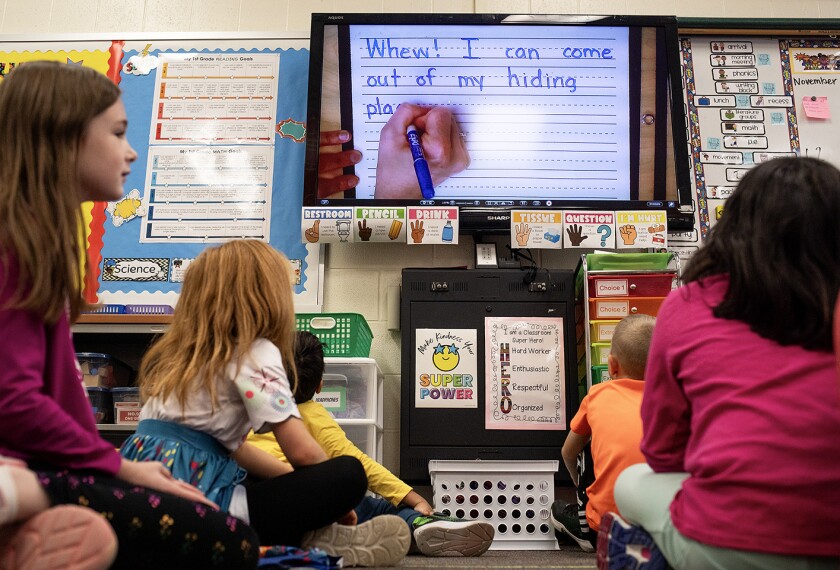This is part 2 of a two-story look at the principal role in leading change in how schools teach reading. Part 1 explored ways districts are equipping principals with supports; in this story, principals share their own learning trajectories.
Within a year of taking up the principal role at Hobgood Elementary in Murfreesboro, Tenn., Quinena Bell had two major, overlapping challenges to grapple with. The school went into a pandemic-induced lockdown and chose to switch to a new literacy curriculum based heavily on the science of reading.
Hobgood coped the best it could with online classes. But when the school reopened, Bell couldnŌĆÖt ignore the huge drop in literacy scores. They propelled her into urgent action.
ŌĆ£We knew everything we did from then on had to be worth the time we spent on it,ŌĆØ Bell said. She buckled down on the new literacy curriculumŌĆöa far cry from the loose mixture of instructional strategies applied beforeŌĆöas a means to get studentsŌĆÖ scores up across the board.
What followed was a multi-year effort to adopt the curriculum across the school. Teachers had to dissect and understand the research on reading, and then steep themselves in the instructional practices needed to apply that research in classroom lessons. Bell had to transform, tooŌĆöfrom a former math coach to a principal who knew the curriculum well enough to give teachers granular feedback on its implementation.
ŌĆ£I had to be vulnerable ŌĆ” this isnŌĆÖt how I was taught reading,ŌĆØ said Bell, whoŌĆÖd attended Hobgood as a child. ŌĆ£This isnŌĆÖt how I learned how to read.ŌĆØ
BellŌĆÖs position isnŌĆÖt unique. So far, 38 states have passed policies or legislation aiming to overhaul how reading is taught. For those efforts to be successful, principals play a pivotalŌĆöand largely unheraldedŌĆörole.
That role is both granular and grand, according to Emily Freitag, the CEO of Instruction Partners, a national organization that trains principals and other instructional staff to adapt to big curricular shifts.
ŌĆ£Principals need to know a lot about the curriculum, like the sequence in which letter sounds are taught,ŌĆØ said Freitag, referring to the foundational technique of phonics, or ŌĆ£sounding outŌĆØ words to learn them.
But itŌĆÖs equally important for principals to zoom out and have a detailed map of the whole operation in their headsŌĆöto direct teachers toward the right training, rework the school schedule to incorporate reading blocks, and keep a close watch on how new curricula and practices are being implemented in the classrooms.
Principals and teachers train together on ŌĆśscience of reading,ŌĆÖ but have distinct roles
There are effectively two phases to principal learningŌĆölearning the science itself, and understanding how itŌĆÖs embodied in lessons.
Principals and teachers usually sit through the same district trainings on the content and pedagogy, but principals also need a different space to ask their own questions about how to lead their schools through big changes in instruction, Freitag said.
For some school leaders, like Bell, the training can completely change their perspective about how students learn to read.
ŌĆ£I thought I knew how to teach reading as an academic coach. But there were several practices, like splitting up reading and writing, that donŌĆÖt help kids at all,ŌĆØ Bell said.
New training helped Dana Perez, also a first-time principal at Pembroke Elementary School in Danbury, Conn., see how different concepts like decoding, encoding, phonemic awareness, and background knowledge, worked together in the curriculum that her school district had picked.
ŌĆ£IŌĆÖd only taught middle school as a teacher, when most kids have already crossed that foundational reading stage. I thought of all these strategies as disparate ones. My biggest learning [from the training] was that reading strategies are a continuum,ŌĆØ Perez said.
But for many principals, this training is tested when they guide their teachers in implementing a new curriculum well. Learning it at least partly alongside teachers can help; Perez sits through every feedback session between the district coaches and the teachers, so she can hear the questions teachers have about new materialsŌĆöand what kinds of feedback teachers may need.
Learning together, said Bell, also meant less confusion and anxiety about what the new curriculum would look like in practice. Together, they shared a clear view of the assessments and outcomes.
ŌĆ£We all had the same instructional guides, which were very clear on the practices we had to implement. There were no ŌĆśgotchaŌĆÖ moments ŌĆ” teachers knew what we expected from them,ŌĆØ she said.
Both principals also meet with instructional coaches on their own, to discuss student performance and go over implementation successes, challenges, and trends. These focused sessions, Perez said, give her the confidence to carry on her observations and feedback when the district coaches arenŌĆÖt by her side.
What principals look for in classrooms during the shift to ŌĆśscience of reading
All that learning doesnŌĆÖt mean that itŌĆÖs always an easy row to hoe. Problems can crop up from the very start.
Chandra Phillips, the principal of Central Elementary School in Seaford, Del., remembers walking into classrooms with timers a decade ago, when her district had just adopted a new literacy curriculum. She was then the assistant principal, and part of the leadership team responsible for helping teachers get up to speed with a new instructional routine.
The timers were essential because the new curriculum hinged on three reading blocks of 45 minutes each, and she had to find the time to fit them into the school schedule and make sure teachers covered them.
Armed with the timers, Phillips would help her teachers tweak their lessonsŌĆödial down the discussion over a book, dial up the writing practiceŌĆödepending on the grade level.
With over 10 years of implementation under her belt, Phillips, now the principal at Central, doesnŌĆÖt have to watch the lesson plans as closely, or pull out her timer for every observation. But newer principals, like Perez, must master the content and rhythm set by their curriculum.
Perez, the Connecticut principal, noticed recently that some teachers were skipping over fundamental routines they needed to establish early in the rollout.
ŌĆ£69┤½├Į need to know how to transition from read-aloud time to writing to independent study. If they donŌĆÖt learn how to do this early, teachers struggle in the following units,ŌĆØ she said.
Even then, problems persist, some of which reflect the scope of the challenge of increasing all studentsŌĆÖ reading proficiency. ItŌĆÖs been hard, Perez acknowledged, to find blocks in the schedule where teachers can pay special attention to students who are struggling to read at grade level, or to input student data onto a centralized platform that helps monitor student progress.
As teachersŌĆÖ ŌĆśscience of readingŌĆÖ knowledge improves, principals can step back
The first part of implementation can be the rockiest. Right now, Perez visits classrooms every four weeks and tracks her teachersŌĆÖ progress from one unit to the next.
With time, though, principals can take a more relaxed approach, and shift their role from administrators to facilitators of continued learning. A decade later, PhillipsŌĆÖ literacy teachers are deeply familiar with their content, so most of her feedback is about maximizing student engagementŌĆömixing up how teachers host student discussions or going a bit deeper into some of the curriculumŌĆÖs themes and topics. Recently, she said, a teacher brought in a baseball for students who had never seen or watched a game and were having a hard time connecting to a lesson on that theme.
In her journey as an instructional leader, Bell falls halfway between Phillips and Perez. There are some battles sheŌĆÖs largely won, like dealing with the initial resistance to the curriculum.
ŌĆ£I had to put my foot down. Just because they had done things a certain way before the new curriculum wasnŌĆÖt a good enough reason to resist change,ŌĆØ said Bell. She leaned on the early adopters, who were quick to extoll the benefits of the curriculum to the more resistant teachers. Student outcomes improved, too, which bolstered BellŌĆÖs case.
The job of an instructional leader is never done. And the work is human and emotional.
Freitag believes the resistance is a form of feedback for principals, which eases up as the initial shock of the change passes. ŌĆ£Teachers arenŌĆÖt usually closed to the whole change, but they may find the pacing is off, or a particular text isnŌĆÖt to their liking,ŌĆØ she noted.
Like Phillips, Bellhas learned to be more of a guide than an enforcer. ŌĆ£I make sure my teachers know that my learning walks arenŌĆÖt an evaluation,ŌĆØ she said.
Bell encourages ŌĆ£vertical planningŌĆØ sessions between different grades, which helps a kindergarten teacher connect what theyŌĆÖre teaching to how a student might use their knowledge in 2nd grade. Bell is now trying to get more teachers trained in learning walks to grow a new generation of instructional leaders within the school.
PerezŌĆÖs school is tacking a version of that, too, as it plans to extend the new curriculum from 3rd grade to 4th and 5th grades. In preparation, Perez has given the grade-level teachers access to all the planning and coaching documents, and the materials theyŌĆÖre going to be teaching.
As for her own capacity to handle two extra grades, Perez has a clear view of how sheŌĆÖs going to navigate this challenge.
ŌĆ£ItŌĆÖs not possible to know everything ŌĆ” and be specialized in [areas like] ESL,ŌĆØ she said. ŌĆ£What matters is how I collaborate with those leaders in the district who are experts in their own areas and get them to support me and my teachers.ŌĆØ
And the process is continuous, reminds Freitag. ThereŌĆÖs always something that needs to be fixed, or a new benchmark to be met.
ŌĆ£The work is never done,ŌĆØ she said. ŌĆ£And the work is human and emotional.ŌĆØ







